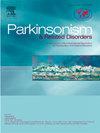区域灰质体积无法预测帕金森患者对眼下丘脑深部脑刺激的轴向症状反应。
IF 3.4
3区 医学
Q2 CLINICAL NEUROLOGY
引用次数: 0
摘要
导言:帕金森病(PD)患者对眼下核深部脑刺激(STN-DBS)的轴向症状反应各不相同。这项单中心回顾性研究旨在评估常规磁共振成像(MRI)的成像生物标志物,以预测对 STN-DBS 的轴向症状反应,特别是使用间脑、脑桥、中脑和上脑梗塞体积指数("MR PIGD 指数"):我们使用MDS-UPDRS III、Berg平衡量表、步态冻结问卷(FOG-Q)和Ziegler病程对94名PD患者进行了术前和术后3至6个月的调查,并使用回归分析和偏最小二乘法相关分析将其与区域脑容量测量信息联系起来:结果:STN-DBS能显著改善轴性帕金森病症状,但改善程度不一。MR PIGD指数和其他皮质脑容量均不能预测术后轴向症状的改善程度:结论:磁共振成像区域灰质体积无法预测 STN-DBS 对帕金森病的反应。本文章由计算机程序翻译,如有差异,请以英文原文为准。
Regional gray matter volumes are not predictive of axial symptom response to subthalamic deep brain stimulation in Parkinsonian patients
Introduction
In Parkinson's disease (PD), axial symptom response to deep brain stimulation of the subthalamic nucleus (STN-DBS) is heterogeneous. This single-center, retrospective study aimed to assess imaging biomarkers of routine magnetic resonance imaging (MRI) to predict axial symptom response to STN-DBS, specifically by using an index of volumes of mesencephalon, pons, middle, and superior peduncle (“MR PIGD index”).
Methods
We investigated 94 PD patients pre- and three to six months postoperatively by using MDS-UPDRS III, Berg Balance Scale, Freezing of Gait Questionnaire (FOG-Q) and Ziegler Course, which were related to regional brain volumetry information using regression analysis and partial least squares correlation analysis.
Results
STN-DBS led to significant, but heterogeneous improvement of axial PD symptoms. Neither the MR PIGD index nor other cortical brain volumes predicted the extent of the postoperative, axial symptom improvement.
Conclusions
Response to STN-DBS in PD cannot be predicted by MRI regional gray matter volumes.
求助全文
通过发布文献求助,成功后即可免费获取论文全文。
去求助
来源期刊

Parkinsonism & related disorders
医学-临床神经学
CiteScore
6.20
自引率
4.90%
发文量
292
审稿时长
39 days
期刊介绍:
Parkinsonism & Related Disorders publishes the results of basic and clinical research contributing to the understanding, diagnosis and treatment of all neurodegenerative syndromes in which Parkinsonism, Essential Tremor or related movement disorders may be a feature. Regular features will include: Review Articles, Point of View articles, Full-length Articles, Short Communications, Case Reports and Letter to the Editor.
 求助内容:
求助内容: 应助结果提醒方式:
应助结果提醒方式:


